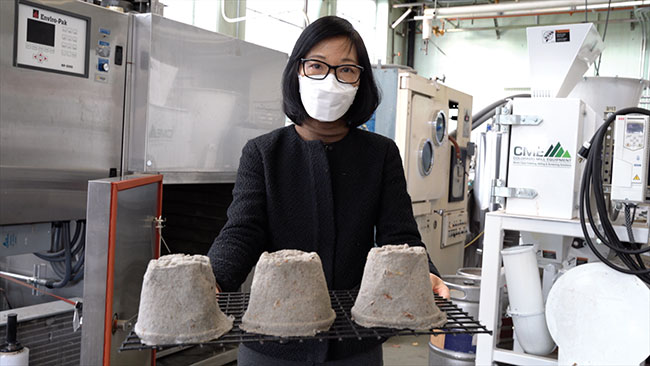
Features
Oregon State University researchers advance apple pulp as packaging material
April 9, 2022 By Sean Nealon
 Oregon State
University professor Yanyun Zhao stands with samples of moulded apple pulp packaging. Photo courtesy of Sean Nealon, Oregon State University.
Oregon State
University professor Yanyun Zhao stands with samples of moulded apple pulp packaging. Photo courtesy of Sean Nealon, Oregon State University. A new study by Oregon State University scientists outlines a key advance in turning apple waste into an environmentally friendly packaging material that could be an alternative to plastic.
Recycled newspaper has traditionally been the main ingredient of so-called moulded pulp packaging products, which have become increasingly popular because they are compostable. But the supply of recycled newspaper is in decline, creating a market for substitute materials.
Yanyun Zhao, an Oregon State professor who leads a research team focused on sustainable food packaging and processing, has studied apple pomace and other byproducts from processing fruit and vegetable juice and winemaking as an alternative for recycled newspaper in molded pulp manufacturing. She and the team have received a patent for this research.
“Right now, apple pomace is typically just composted or used for animal feed,” said Zhao, whose research aims to reduce food loss and waste across the food supply chain. “We thought why not turn it into an environmentally friendly product that meets an industry need.”
Zhao envisions apple pomace being the main ingredient for molded pulp packing products such as take-out containers, flower pots, beverage cartons and bottles, and clamshell packaging used for fruits and vegetables.
She is focused on apple pomace, in part, because it is readily available in the Pacific Northwest. When apples are processed for juice about 70 to 75 per cent of the apple goes into the juice, leaving the remaining 25 to 30 per cent as pomace.
One of the key problems to solve in creating pomace and paper-based packaging is improving water resistance so that it can withstand high moisture, liquid food, or non-food items and products stored under high humidity conditions.
In a recently published paper in Food and Bioproducts Processing, the team sought to create eco-friendly, bio-based, compostable and cost-effective solutions that would improve the hydrophobicity, or water resistance, of the apple pomace-based molded pulp products.
They used two strategies: incorporating polymers and compounds with characteristics to improve water resistance into the pulp formulation and applying superhydrophobic coatings on the product surface. The polymers and compounds studied include lignin, chitosan and glycerol.
The researchers determined the optimal amounts of those polymers and compounds while also adding a small amount of cardboard fibre for stability of the molded pulp packaging products.
Zhao’s team previously created a two-step preparation of superhydrophobic coating that is heat-, cold- and water-resistant. They applied a simplified, one-step coating on the surface of the apple pomace-based product to enhance water resistance.
The team concluded that the study demonstrated the feasibility of using fruit pomace as a new source of fibre in producing moulded pulp packaging and effective approaches to enhancing water resistance in those packaging materials.
Co-authors of the paper are Clara Lang, Jooyeoun Jung and Taoran Wang, all of whom are former or current members of the Sustainable Food Packaging and Processing team in Oregon State University’s College of Agricultural Sciences.
The research was supported by the Oregon Department of Agriculture Specialty Crop Block Grant Program. Kerr Concentrates, Inc. of Salem and Hood River Juice Company of Hood River provided fruit pomace for the research.
Print this page